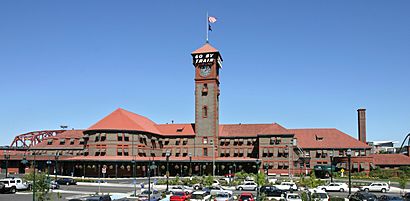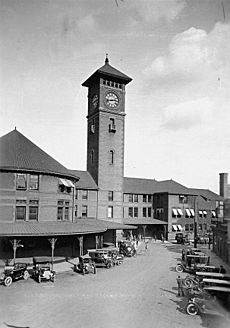Portland Union Station facts for kids
Quick facts for kids
Portland Union Station
|
||||||||||||||||||||||||||||||||||||||||||||||||||||||||||||||||||||||||
|---|---|---|---|---|---|---|---|---|---|---|---|---|---|---|---|---|---|---|---|---|---|---|---|---|---|---|---|---|---|---|---|---|---|---|---|---|---|---|---|---|---|---|---|---|---|---|---|---|---|---|---|---|---|---|---|---|---|---|---|---|---|---|---|---|---|---|---|---|---|---|---|---|
 |
||||||||||||||||||||||||||||||||||||||||||||||||||||||||||||||||||||||||
| Location | 800 Northwest Sixth Avenue Portland, Oregon, U.S. |
|||||||||||||||||||||||||||||||||||||||||||||||||||||||||||||||||||||||
| Coordinates | 45°31′44″N 122°40′36″W / 45.529°N 122.6768°W | |||||||||||||||||||||||||||||||||||||||||||||||||||||||||||||||||||||||
| Owned by | City of Portland (Prosper Portland) |
|||||||||||||||||||||||||||||||||||||||||||||||||||||||||||||||||||||||
| Line(s) | Union Pacific Railroad | |||||||||||||||||||||||||||||||||||||||||||||||||||||||||||||||||||||||
| Platforms | 1 side, 2 island platforms | |||||||||||||||||||||||||||||||||||||||||||||||||||||||||||||||||||||||
| Tracks | 5 | |||||||||||||||||||||||||||||||||||||||||||||||||||||||||||||||||||||||
| Connections | ||||||||||||||||||||||||||||||||||||||||||||||||||||||||||||||||||||||||
| Construction | ||||||||||||||||||||||||||||||||||||||||||||||||||||||||||||||||||||||||
| Parking | Yes | |||||||||||||||||||||||||||||||||||||||||||||||||||||||||||||||||||||||
| Bicycle facilities | Yes | |||||||||||||||||||||||||||||||||||||||||||||||||||||||||||||||||||||||
| Disabled access | Yes | |||||||||||||||||||||||||||||||||||||||||||||||||||||||||||||||||||||||
| Other information | ||||||||||||||||||||||||||||||||||||||||||||||||||||||||||||||||||||||||
| Station code | PDX | |||||||||||||||||||||||||||||||||||||||||||||||||||||||||||||||||||||||
| History | ||||||||||||||||||||||||||||||||||||||||||||||||||||||||||||||||||||||||
| Opened | 1896 | |||||||||||||||||||||||||||||||||||||||||||||||||||||||||||||||||||||||
| Rebuilt | 1996 | |||||||||||||||||||||||||||||||||||||||||||||||||||||||||||||||||||||||
| Traffic | ||||||||||||||||||||||||||||||||||||||||||||||||||||||||||||||||||||||||
| Passengers (2017) | 597,127 |
|||||||||||||||||||||||||||||||||||||||||||||||||||||||||||||||||||||||
| Services | ||||||||||||||||||||||||||||||||||||||||||||||||||||||||||||||||||||||||
|
||||||||||||||||||||||||||||||||||||||||||||||||||||||||||||||||||||||||
|
||||||||||||||||||||||||||||||||||||||||||||||||||||||||||||||||||||||||
|
Union Station
|
||||||||||||||||||||||||||||||||||||||||||||||||||||||||||||||||||||||||
| Lua error in Module:Location_map at line 420: attempt to index field 'wikibase' (a nil value). | ||||||||||||||||||||||||||||||||||||||||||||||||||||||||||||||||||||||||
| Area | 7 acres (2.8 ha) | |||||||||||||||||||||||||||||||||||||||||||||||||||||||||||||||||||||||
| Built | 1890-96 | |||||||||||||||||||||||||||||||||||||||||||||||||||||||||||||||||||||||
| Architect | Van Brunt & Howe | |||||||||||||||||||||||||||||||||||||||||||||||||||||||||||||||||||||||
| Architectural style | Romanesque Revival | |||||||||||||||||||||||||||||||||||||||||||||||||||||||||||||||||||||||
| NRHP reference No. | 75001595 | |||||||||||||||||||||||||||||||||||||||||||||||||||||||||||||||||||||||
| Added to NRHP | August 6, 1975 | |||||||||||||||||||||||||||||||||||||||||||||||||||||||||||||||||||||||
Portland Union Station is a famous train station in Portland, Oregon, USA. It sits close to the Willamette River in the city's Old Town Chinatown area. This station is a stop for Amtrak's Cascades and Coast Starlight trains. It's also one of the two main end points for the Empire Builder train, which travels all the way to Seattle.
Union Station is a big transport hub where you can connect to other ways of getting around. You can find MAX Light Rail trains at nearby stations. The Portland Streetcar and several local and long-distance bus services are also close by. Inside the station building, there's a restaurant called Wilf's. The upper floors have offices. It also has a special lounge for first-class train passengers.
Southeast of the station, the train tracks make a sharp turn. They cross the river on the old Steel Bridge. To the northwest, the tracks follow the river. They go through train yards before crossing the river again on the Burlington Northern Railroad Bridge 5.1.
The city of Portland owns the station. It is managed by Prosper Portland, which is the city's urban renewal agency.
Contents
Train Services at Union Station
Union Station is a very important place for travel in Portland and Oregon. It connects many different types of transportation.
Connecting to Local Transit
You can easily connect to TriMet's MAX Light Rail trains here. The Green and Yellow Line trains stop at nearby stations. Local bus services from TriMet are also available. Union Station is at the north end of TriMet's transit mall. It's also a short walk to both lines of the Portland Streetcar in the Pearl District.
Long-Distance Train Routes
Union Station is one of the two western starting points for the Empire Builder. This is Amtrak's main long-distance train that goes to the Pacific Northwest. The train splits in Spokane. One part goes to Portland through the Columbia River Gorge. The other part continues to Seattle.
The station is also a stop for the Seattle to Los Angeles Coast Starlight train. This is Amtrak's long-distance train that travels along the West Coast. Union Station is the southern end for two daily Cascades trains from Vancouver, British Columbia. It's also the northern end for two Cascades trains from Eugene. Four daily Cascades trains from Seattle also stop here.
In 2018, Union Station was the fifth busiest Amtrak station in the Western United States. It was the 21st busiest Amtrak station overall.
Bus Connections
Portland's old Greyhound bus terminal was right next to Union Station. Greyhound moved from downtown to this building in 1985. However, Greyhound left this building in September 2019. They now use a pickup spot nearby.
Station Design and Location
Union Station is located near the western side of the Willamette River. This is in downtown Portland's Old Town Chinatown area. The station is surrounded by several streets. These include Northwest Glisan, Hoyt, and Irving streets to the south. Northwest Broadway Street and Station Way are to the west. Northwest Overton Street and Naito Parkway are to the north. Industrial and commercial areas are to the east.
History of Union Station
The first idea for the station was made in 1882. If that plan had been built, it would have been the biggest train station in the world! A smaller design was created by architects Van Brunt & Howe. This plan was approved in 1885.
Construction of the station began in 1890. The Northern Pacific Terminal Company built it for $300,000. It officially opened on February 14, 1896. The most famous part of the building is its 150-foot-tall Romanesque Revival clock tower.
The Famous Neon Signs
In 1948, bright neon signs were added to the tower. The signs on the northeast and southwest sides said "Go by Train." The signs on the northwest and southeast sides said "Union Station."
In March 1971, the neon signs went dark. This happened because the railroads were getting ready to transfer their passenger services to Amtrak. The company that owned the station decided to turn off the signs.
In 1985, two local groups worked together to bring the signs back. They raised money from public donations. New neon tubes were put in during July. The signs were turned back on in September 1985. The "Union Station" signs stay lit all the time. The "Go by Train" signs flash on and off. They show "Go," then "Go by," then all three words, then off, and then repeat.
Renovation and Modern Use
In 1987, the city of Portland took over ownership of the station. This was part of a plan to improve the downtown area. Soon after, Union Station went through a big renovation. It was celebrated again in 1996 after the updates.
In 2004, the road in front of the station was changed. This created a new connection and a front area. Also, the area around the station is being redeveloped. New homes are being built where train tracks used to be.


